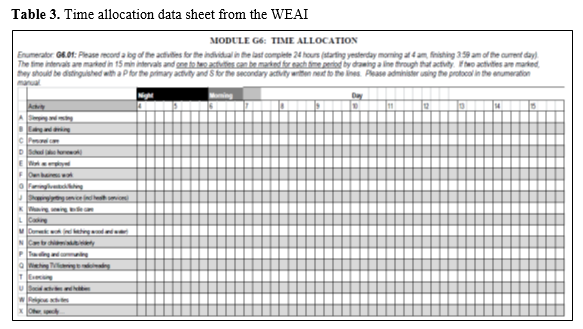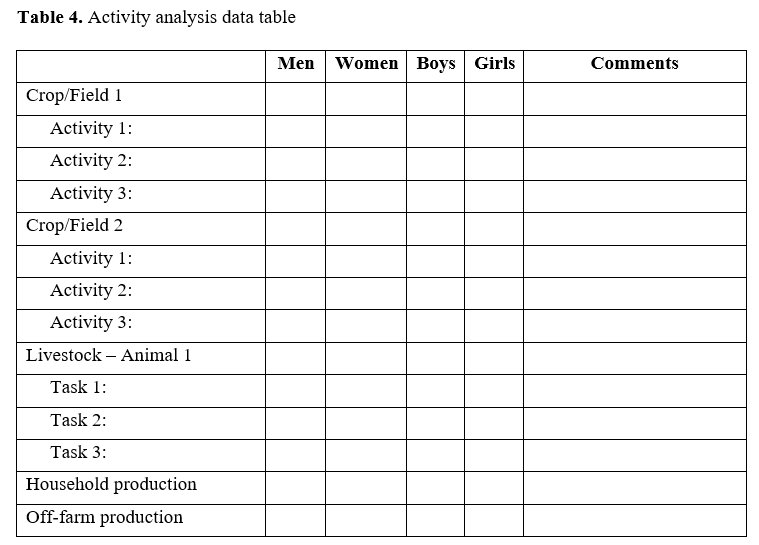You are here
Time Allocation By Gender
This metric can be used to assess gender equity through the quantitative measurement of differences in time spent on various tasks. While the division of labor by gender is not inherently negative, it is possible to assess gender equity by comparing amounts of leisure time for each gender or comparing time spent on the least desirable or most taxing tasks. Also, this information can be combined with other metrics in the agency and resource categories to assess who benefits from how the time is spent. Rao (2016) recommend the following metrics for gender labor inequities: “Average hours of leisure for women and for men or proportions of women and men who report inadequate leisure time”
Depending on the technology being assessed, it may be useful to develop detailed time allocation for activities directly or indirectly affected by that technology. In general, one can partition labor analyses into three broad categories—agricultural tasks (including livestock care), non-agricultural income generating tasks, household chores and leisure time. When inquiring about the time required for non-seasonal tasks, like household chores, it is common to ask about an “average” day. However, when inquiring about the time required for season tasks, such as crop production, there is no “average” day. Instead one can ask about all the agricultural activities (land preparation, planting, weeding, fertilizing, harvesting, etc.) field by field.
How to operationalize the metric
Method of data collection and data needed to compute the method:
CARE’s Daily Time Use exercise can be used to explore the differences between men’s and women’s daily activities, as described in the box below.
CARE’s Daily Time Use exercise
Objective: To explore and increase awareness of gender differences between women’s and men’s daily activities.
Materials/Preparation: large sheets of paper, pens.
Participants: This exercise has been used for both analysis and training.
- Mixed groups of men and women in different ethnic/caste or socioeconomic groupings.
- Single-sex groups.
- Staff or research teams to critically reflect on gender roles.
- Boys and girls, divided into single-sex groups
Steps:
Following introductions and description of objectives, participants split into two groups by gender. The men’s and women’s groups separately list all the activities in their daily schedule, from waking to going to sleep. Each activity is drawn on an idea card and laid out in order across the day.
For this tool, it is important to specify what type of day is at the focus of the exercise, perhaps a day during the busiest time of the season, or after the harvest. The Exploring Dimensions of Masculinities exercise focuses on a typical weekday and a typical weekend day for its workshop with urban adolescent boys.
The group then reviews the day, and the facilitator discusses:
- Where does each activity take place? And with whom?
The facilitator then asks the group to identify which activity takes the most time. Next to that activity, the group places 10 stones. The group then identifies the second- most time-consuming activity, and decides how many stones to place there. This continues until each activity has stones next to it to show the amount of time required.
After this is completed, the facilitator asks the participants to list the activities across the daily schedule of someone of the opposite gender.
Once completed, the groups join together and the men and women each present their schedule to the whole group. When both schedules have been presented, the facilitator discusses:
- What surprised you about this exercise?
- Did the men accurately list women’s activities? Did the women accurately list men’s activities?
- Is there a difference in the kind of activities that men and women do? What is the difference?
- Probe: What is the reason for the difference? Does society expect very different things from men and women? Why does society expect men and women to spend time in different ways?
- Probe: Do you think this difference is justified? Why or why not?
- Which kind of work is a person paid for? Which kind of work is a person not paid for? Why?
- Which group has more leisure time to spend as they like? Which group has a larger workload?
- Probe: Is this justified? Why or why not?
- Was sex listed on the daily schedule? Why or why not? If it was added, would it be listed the same way in all the groups’ daily activity schedules? Do men and women have the same expectations for sex? Why or why not?
- How much variation from this general daily activity schedule happens in your community? Do you see some particular men or women acting differently? Why is that?
- How does their reputation in the community change if they are not conforming to the norm?
- Are there certain ways that you would like to change community expectations of the daily activity schedules and workloads of men and women? What are they? Describe them. What can you do to make these changes happen? What can others do? How can this project contribute to those changes?
In addition, the facilitator may ask groups to place values alongside each activity:
- “H” (or another symbol) for tasks that are highly valued.
- “P” (or another symbol) for tasks that are paid with money.
- “R” (or another symbol) for those paid with respect/prestige.
- “U” (or another symbol) if it is unpaid.
Once completed, groups discuss their observations regarding the chart. The team then reflects on how the chart may change based on age or class. Teams may also discuss the roles of boys or girls in each of these tasks.
Variations:
Representing activities with tools: Rather than ask participants to draw, the facilitator can ask participants to gather the tools/utensils that they associate with each time period and lay them across a paper with the hours of the day to illustrate the activities. This is done with men and women side by side. The research team can then facilitate a discussion around the matrix and tools on the different daily activities done by men and women.
Activity pie chart: While the Daily Time Use exercise has been used with children, another variation asks separate groups of boys and girls to list the activities they undertake during the day. In the Power to Lead Alliance, this exercise was facilitated with 10-11-year-old girls in one group and 12-14-year-old girls in another group.
This exercise begins with discussing the various activities or tasks that girls (or boys, in a separate discussion) do during the day. Make a list of the key activities together. Then invite one participant to draw a large circle on the ground or on a chalkboard. This circle represents a 24-hour day.
Explain that the group will now divide the circle into pie pieces, each representing one activity or task they have listed. The size of that piece should represent the time spent on that task. One way to represent the chart is to show or discuss what an orange looks like when it is cut into parts, with the wedges visible.
It may be helpful to start with the process by discussing how many hours of sleep girls get each night, and allocating that piece first.
Let the participants discuss and mark sizes themselves, as early as possible. The facilitator should focus on posing clarifying questions or probing for further discussion (e.g., “I see that this piece looks bigger than that one, so you spend more time fetching water than preparing dinner? Is this the same for everyone?”)
If the typical day is a school day, discuss how they spend their time in school (e.g., lessons, chores, meals, recess)
When the group finishes the chart, participants should review their list to be sure that each task has been included. They should note the amount of time allocated for each activity. Reviewing the list and adding the amount of time helps to confirm and clarify the pie drawing for analysis.
Following the activity, further discussion questions may include:
- If you were free to change your schedule, how would you spend your time differently?
- How might you work with others to change how you spend your time?
If separately performed with boys and girls, the groups can then be brought together in a subsequent activity to discuss and compare the two time-use pie charts.
Similarly, the CCAFS gender toolkit has a daily activity clock exercise. That manual suggests drawing two circles – one from 6 a.m. to 6 p.m. and the other from 6 p.m. to 6 a.m. – and then using the circles to map out pie-shaped pieces to represent time spent on various activities.
As Jost et al. (2014, p. 135) explains: “Be creative in how you use the different spaces (pieces of pie) to visually represent information. For example, once the clock is complete give the participants a pile of 100 beans to show the activities they feel are relatively more demanding or labor intensive compared to others. Or they can show the activities they find relatively enjoyable and rewarding compared to others. Or you can ask them to place a stone or other marker to show activities during which they obtain other benefits, like sharing information with others.”
Unit of analysis:
Content here
Limitations regarding estimating and interpreting:
Content here
Method of data collection and data needed to compute the method:
The Women’s Empowerment in Agriculture Index (WEAI) survey provides guidelines for estimating the number of hours worked per day in order to calculate its time allocation component of the empowerment index (Alkire et al., 2013). It recommends asking people about how they spent their time from 4:00 a.m. the previous day to 3;59 a.m. the next morning. The various activities are predefined and can be recorded in 15-minute intervals. Respondents can provide up to two activities at any one time, but will be asked which activity is primary. Following is the first page of the table for data collection. The second page has the same activities for the remaining hours of the 24-hour period.
Unit of analysis:
Content here
Limitations regarding estimating and interpreting:
Alkire et al. (2013) note that a major shortfall of the WEAI method is that it does not cover seasonality and may not be representative of the given season if the previous day was a holiday. Harvey and Taylor (2000) recommend asking respondents about activities that took place no more than one or two days previous to the interview, as memory fades on the detailed use of time beyond that.
Harvey and Taylor (2000) also point out the importance of adapting all these tools to the local context using local terms for how time is reckoned. In addition, they note that data generated from questions asking only about specific activities (e.g., carrying water, weeding, collecting firewood) are susceptible to significant reporting errors compared to more rigorous methods like the stylized activity log used in the WEAI time module.
Method of data collection and data needed to compute the method:
The goal of this exercise is to understand who does each activity. This can be a binary question for each gender (i.e., yes or no) or it could be a proportional assessment of time spent on each task (i.e., percent, or proportionally allocating 10 stones by gender). This analysis could be implemented through individual interviews, couple interviews, or larger groups (e.g., several couples, separate groups of women and men).
Unit of analysis:
Content here
Limitations regarding estimating and interpreting:
Content here
Method of data collection and data needed to compute the method:
In order to collect this information, symbols can be used for each gender, tasks from the activity analysis above can be referenced, or a separate calendar can be done for men and women.
Unit of analysis:
Content here
Limitations regarding estimating and interpreting:
Content here




